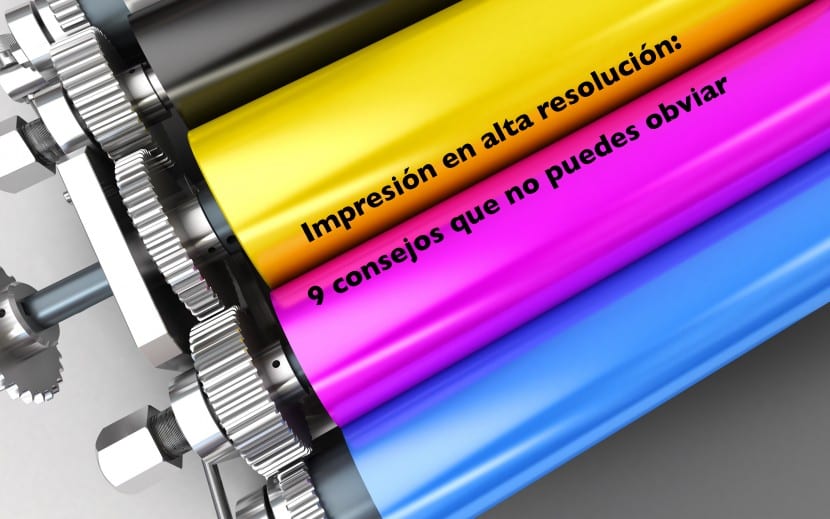
Printing graphic documents and photos is a tremendously important phase. We need to take into account different aspects to obtain an optimal result and it is that many times a careless impression or an impression that ignores certain factors gets to impoverish long periods of work. More than once it will have happened to you that you dedicate yourself entirely to a project but when it comes time to print it and see it on paper you discover that it has lost quality and definition.
Here are nine basic tips to avoid this type of situation and protect our work on any display support. Keep reading!
- Capture format: It is something that has a powerful influence on the final result of our images and is that depending on the format we choose we will find different benefits. In principle, shooting in RAW is essential if what we want is to obtain an archive with all the information of the captured image. The point that we find against is that it occupies much more than an image in JPG format, but RAW ensures that our image will not lose quality even if we apply effects or adjustments afterwards.
- Get a RAW editor: When using a RAW editor we will keep the characteristics of the original file without altering it, since what an editor will do is save the changes that we have defined to apply them in the export phase and not on the main file.
- Measure your steps in editing: When we view our images on different media the differences in quality are considerable. Surely you have ever edited a photograph on your mobile phone obtaining a great result, however when exporting the photograph to a computer you discover that it has lost a lot of quality. Well, the same thing happens when we edit photos from Photoshop and then print them. Hard effects especially tend to reflect these quality losses.
- Monitor calibration: This is essential since what we see on the screen must be adjusted to what we are going to print later or also to what other people see from their screens (if they are calibrated correctly). There are different options to calibrate our monitors in an efficient and accurate way. Although you can do it yourself, you can also use hardware such as Quick Gamma or softwares to do it more professionally and adjust to our needs. Calibration is essential to be able to obtain a higher degree of accuracy when we work.
- Color ranges and profiles: A color spectrum refers to the ability of our visual system to capture and identify color information. Our eye has a much greater range than any screen could present. For this reason, to know what is the amplitude and "capacity" that our monitor has to capture colors, we find several standards. Among them sRGB that covers 35% of the visible spectrum or AdobeRGB that captures 50%. Nor should we ignore the use of color profiles because thanks to them our color management system will be able to identify the real colors that make up our composition and convert them to the space or color range that our support uses. We will not use the same range if we reproduce our image on an electronic support such as a camera, a smartphone or a computer, or if we are doing it from a paper support.
- Check the resolution of the image: To print in high quality it is necessary that we have a resolution of 300 or 400 pixels per inch. We can find out what our margin is regarding the size to print our image at a high quality from the Image> Image size menu from the Photoshop application where a dialog box will appear with the resolution in pixels per inch of our image and where we can modify the values to get the most suitable result.
- What format to use ?: We have a wide variety of formats with which we can export, edit and save our work. On the one hand, RAW brings together all the information, TIFF is a format without any compression, PNG offers us the possibility of exporting transparencies, GIF is intended for animations and PSD allows us to save the layers created in Photoshop. On the other hand, one of the most used is JPG, but its disadvantage is that it is compressed and each time we use it and edit it, it will lose quality, although its strong point is its reduced weight. Depending on our intentions, we must use one or the other, but in principle TIFF is the most appropriate option for printing without losing information during the process.
- The role factor: There are different types of photo printing papers that vary based on weight, gauge, and finish. Depending on the type of project we are dealing with, we will choose one or the other option. For example, the brighter solutions offer more wild and marked contrasts and the matte solutions are more balanced in terms of darks and contrasts.
- The printer is also important: Logically all these points lose sense if after configuring everything we do our printing on a low quality machine. For this reason, it is important that we get a high-quality printer that offers us decent results and offers us the possibility of printing on different types of paper, sizes and formats. We will discuss this in more depth in a future article. For now, keep in mind that if we talk about printing, the destination and end of the entire procedure is in our printer, so we must pay attention to the model we have and the alternatives we have if we are going to renew our work tools .
Hello, thanks for the information . regards
I need to print 6 photographs of 30 × 30 in high quality, please contact jvargasbatlle@gmail.com